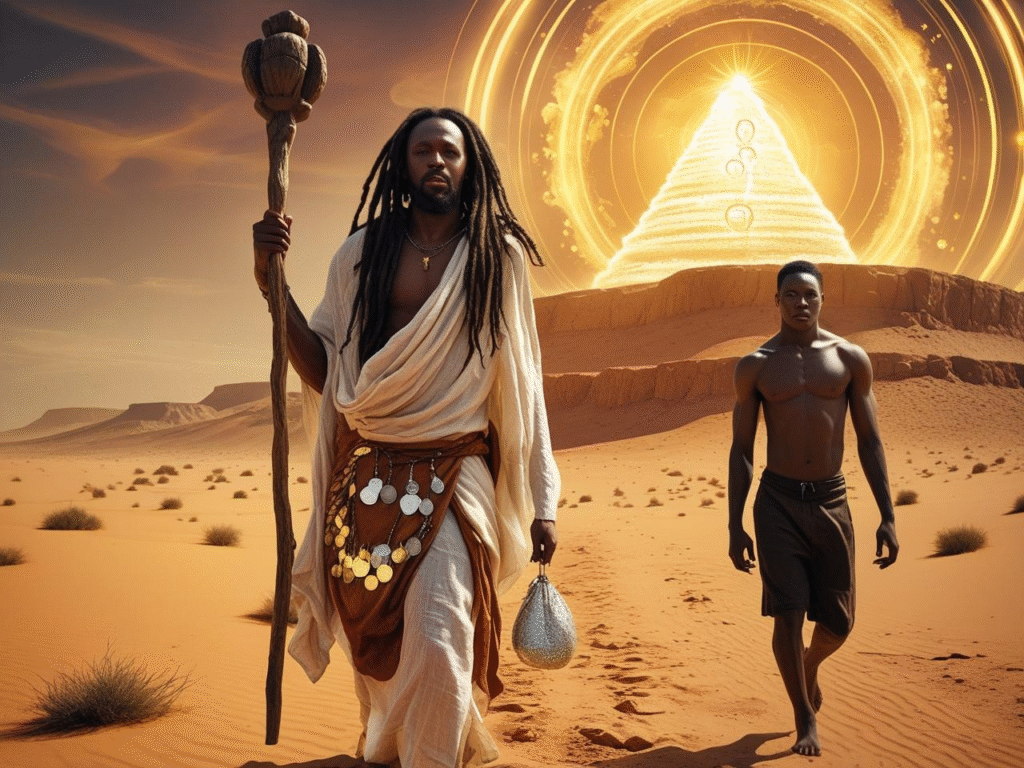
Genesis 13 verse1–3: Going Up to the Negev
✨ Scripture & Ritual Decode
🌟 Chakra Focus: Solar Plexus (Direction, Willpower & Choice)
Scripture Passage
“So Abram went up from Egypt to the Negev, with his wife and everything he had, and Lot went with him. Abram had become very wealthy in livestock and in silver and gold. From the Negev he went from place to place until he came to Bethel, to the place between Bethel and Ai where his tent had been earlier.”
📜 Introduction:
This passage is more than a travel log of Abram leaving Egypt. It marks a turning point of spiritual ascent. Having descended into Egypt (a symbol of bondage, survival, and testing), Abram now “goes up”—a spiritual rising from shadow into alignment. He returns to the place of his first altar, the space between Bethel (“House of God”) and Ai (“ruin”).
In this blog post, we’ll explore:
- How Abram’s journey mirrors our own path of returning to spiritual alignment.
- The metaphysical truth that wealth is not merely material, but the fruit of spiritual obedience and inner resolve.
- How the Emerald Tablets reveal the law of rhythm and return, teaching us why the soul must revisit its earlier steps before advancing further.
- A song—told as a story—that carries the emotional journey of leaving Egypt, carrying abundance, and seeking the altar once again.
🔮 Allegory & Metaphysic Breakdown
- Egypt as Shadow Consciousness: Egypt symbolizes the descent into materialism, survival mode, and external dependency. Abram’s sojourn there mirrors our own moments of misalignment, when fear and famine drive us from trust in Spirit.
- Going Up to the Negev: The “going up” is not geographical only—it’s a vibrational ascension. The Negev (wilderness) is the inner place of testing where strength and clarity are forged.
- Wealth of Abram: Livestock, silver, and gold symbolize abundance of body (livestock = vitality), mind (silver = reflective thought), and spirit (gold = divine illumination). True prosperity manifests across all three realms.
- Returning to Bethel: Abram’s return to the place of the altar is a reminder that spiritual progress requires circling back to the first commitments we made—to re-consecrate ourselves before moving forward.
- Lot as the Lingering Persona: Lot, the ego-fragment or untested self, still journeys with Abram. This reminds us that even when rising higher, unresolved parts of our psyche remain with us until fully integrated or separated.
🪬 Emerald Tablet Deepening
The Emerald Tablets speak of the Law of Rhythm: all things rise and fall, expand and contract, return and advance. Abram’s return to Bethel reflects this universal law—progress is never a straight line, but a spiral.
- “As above, so below”: Abram’s journey upward mirrors the soul’s movement from lower to higher vibrational states.
- “Return to the point of beginning”: The Tablets teach that every cycle demands a return before transcendence. Abram revisits the altar not because he has failed, but because the spiral calls him higher through re-alignment with his earlier vow.
- “Master the cycles”: True mastery comes not in escaping Egypt forever, but in learning to move fluidly between descent and ascent without losing center. The altar is the anchor point of remembrance.
AfroWave AI Song: Return to the Altar
(Afrobeats rhythm, soulful yet strong; verses unfold like a traveler’s story. Sung in a call-and-response style.)
Song Lyrics
Verse 1
I left the land of shadows, where hunger drove my hand,
Carried by the river, deep into Egypt’s sand.
But Spirit kept me moving, my heart would not stay,
Now I rise from the desert, and I’m finding my way.
Chorus
I’m returning—returning to the altar flame,
Where I first called out Your holy name.
Silver and gold, they shine in my hand,
But my soul is the wealth, on this sacred land.
Verse 2
Lot walks beside me, a mirror of my past,
Choices yet to settle, shadows yet to cast.
Through Negev’s burning silence, I carry all I own,
But my spirit longs for Bethel, where love builds a throne.
Bridge
Oh, between the House of God and ruin, I stand,
With the altar of my promise carved in the land.
The cycles bring me back, but higher I climb,
Every step returning, yet beyond all time.
Final Chorus
I’m returning—returning to the altar flame,
Where I first called out Your holy name.
Silver and gold, they shine in my hand,
But my soul is the wealth, on this sacred land.



I love how you unpacked Abram’s journey as more than just a geographic move — the way you tied Egypt to shadow consciousness and the Negev to inner testing made the passage feel alive in a whole new way. The integration of the Emerald Tablets and the “law of rhythm” really highlighted the cyclical nature of spiritual growth beautifully.
The song lyrics at the end were such a unique touch too — they gave the lesson an emotional resonance beyond just the explanation.
I’m curious — when you reflect on Abram’s return to Bethel, do you see that same “return and rise” pattern echoed in other scripture passages you’ve studied?
And since you’ve also written about themes like the End Times, do you feel that understanding these cycles of descent and ascent can give us a better lens for interpreting prophetic scriptures as well?
Hi Kris
Thank you so much for sharing your reflections — I’m deeply touched that the way I wove Abram’s journey, shadow consciousness, and the Emerald Tablet’s Law of Rhythm resonated with you. The patterns hidden in these passages are so alive when we see them through the lens of energy and consciousness.
To your first question: yes, I absolutely see this “return and rise” rhythm echoed all throughout scripture. It’s in Jacob’s ladder, in Israel’s wilderness wanderings, in the Prodigal Son’s homecoming — even in Christ’s descent into the tomb and resurrection. Each cycle carries the same heartbeat: we spiral down into shadow or testing, only to ascend again with greater wisdom, deeper surrender, and more refined light.
And when it comes to prophetic scripture and the so-called “End Times,” I believe this pattern is key. These aren’t one-time, catastrophic events but living cycles — collective descents into shadow, followed by collective awakenings. Seeing prophecy this way shifts us from fear into alignment: instead of waiting for destruction, we’re invited to participate in the ascent, to become co-creators of the “new heaven and new earth” within ourselves first.
I’m so glad the song lyrics spoke to you too — they were meant to carry the energy of the teaching straight to the heart.
With gratitude and light,
Iris
Hi there ????
This was such a powerful reflection. I really like how you connected Abram’s journey with the symbolic meaning behind Egypt, Bethel, and even the Law of Rhythm from the Emerald Tablets. The way you explained livestock, silver, and gold as representing body, mind, and spirit abundance really stood out to me — it adds such a deeper layer to the story.
I do have a question though: when you describe Abram’s return to the altar as a “spiral” instead of a setback, how can we take that same view in our own lives? In other words, how do we see those repeated struggles not as failures, but as important steps that help bring us back into alignment and growth?
God Bless You
Elke ????
Hi there!
Thank you so much for this beautiful reflection—and what a clarifying question. Here’s a simple way I practice seeing “repeat struggles” as a spiral back to the altar instead of a setback:
1) Name the Altar, Not the Error
Abram returns to the place of calling, not the place of shame. When a pattern resurfaces, pause and ask:
What altar (value/commitment) is this leading me back to?
Give that altar a name (e.g., “Truth,” “Peace,” “Integrity,” “Obedience”).
2) Switch from Linear to Spiral Time
Law of Rhythm: tides ebb/flow. On the spiral, you’re meeting a similar lesson at a higher turn. Reframe with:
This is a familiar lesson at a new altitude. What new skill is being asked of me now?
3) The “Livestock, Silver, Gold” Check
Abram’s increase = body–mind–spirit. When the pattern returns, scan:
Body (Livestock): Am I under-rested, under-nourished, or overextended?
Mind (Silver): What story am I telling? Is it fear or faith?
Spirit (Gold): Where did I stop listening/praying/aligning?
Choose one micro-adjustment in each lane (hydrate/rest, replace the thought, reconnect in prayer).
4) Make a Micro-Return (Bethel in 3 minutes)
Breath: 4 slow inhales/exhales.
Truth: Speak one sentence that aligns you: “I choose peace and obedience now.”
Action: Take one small faithful step (send the message, forgive, close the tab, step outside barefoot).
5) Journal the Spiral, Not the Slip
Two prompts:
What did I do better at this turn than last time?
What one practice will keep me aligned for the next turn?
6) Quick Tapping Cue (if helpful)
While tapping gently on the collarbone:
“Even though this pattern showed up again, I honor my progress. I’m meeting it at a higher turn. I return to my altar—body, mind, and spirit—in peace.”
7) Bless the Rhythm
Pray: “God, guide my return. Turn every repetition into revelation, every cycle into communion. Amen.”
When we do this, the “repeat” becomes evidence of faithful orbit—not failure. Just like Abram, every return writes a deeper yes.
God bless you, and thank you again for such a thoughtful question.
This is a powerful reflection — I love how you weave Abram’s journey with the metaphysical symbolism of Egypt, Bethel, and the Law of Rhythm from the Emerald Tablets. The way you framed livestock, silver, and gold as body, mind, and spirit abundance is especially striking; it really deepens the story beyond its surface narrative.
One question: when you describe Abram’s return to the altar as a “spiral” rather than a setback, how can we apply that same perspective in our own lives—so we don’t see repeated struggles as failures, but as necessary stages of alignment and growth?
Hi Jenny — thank you for this beautiful read and for asking the question that sits at the heart of the post.
When I call Abram’s return to the altar a spiral (upward) instead of a setback, I’m saying: the scene is repeating, but the consciousness isn’t the same. In a spiral you meet a familiar point from a wider view—more wisdom, more humility, more alignment. Here are a few ways I practice that in daily life:
1) Name your altar (your North Star).
Write a one-sentence intention you can actually live with this week. Keep it simple: “I return to love in word, tone, and action.” A clear altar gives every “again” a direction.
2) Do a Rhythm Check.
The Emerald Tablets teach that all things move in rhythm. Ask: “Am I in a swing toward contraction or expansion?” On contraction days, choose gentler actions (rest, simplify, tend the body). On expansion days, take bold, spirit-led steps. Rhythm-aware choices turn “back and forth” into “forward by design.”
3) Journal in spirals, not lines.
Use this prompt: “What is the same, what is new, and what is now available that wasn’t before?” That third question proves you’re higher on the coil.
4) Micro-Ritual Return (3 minutes).
Breath: Inhale 4, hold 4, exhale 6 (repeat x5).
Touchpoint: Hand to high heart, say: “I return to the altar within.”
Action: One aligned act (send the message, drink the water, take the walk).
Tiny faithful returns build spiral momentum.
5) Measure alignment, not outcome.
Outcomes swing; alignment steadies. I ask: “Was my tone true? Was my choice clean?” If yes, it’s a win—regardless of the day’s “results.”
6) Reframe the word “again.”
Every time “this pattern again” arises, say: “This is the deeper round.” Same hill, new vantage point.
7) Embody the story (Egypt → Bethel → Altar).
Body (Egypt/Negev • Root & Sacral): Ground, hydrate, eat simply.
Mind (Bethel • Ajna/Throat): Tell the truth gently; choose one thought that serves.
Spirit (Altar • High Heart/Crown): Offer the moment back to God; ask for the next faithful step.
“As above, so below.” When we honor rhythm in the small (breath, tone, step), the large (karma, calling, covenant) begins to harmonize. That’s the spiral.
I’d love to hear what your North Star sentence would be this week—and what feels “the same but newly available” for you right now.